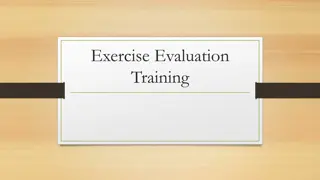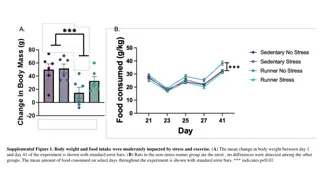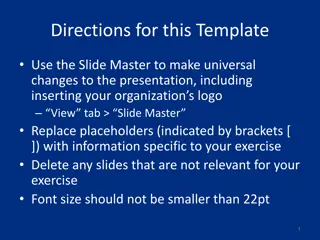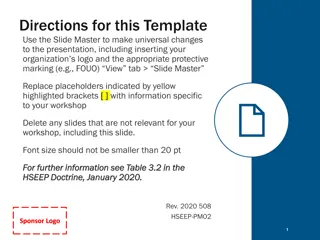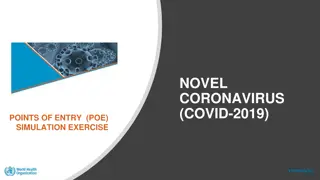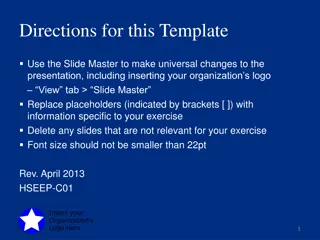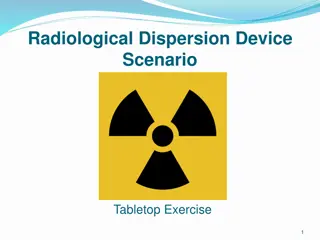Teachings for Exercise 7B
In this exercise, you will explore the application of forces in equilibrium scenarios involving tension, weight, and other forces. Through detailed calculations and diagrams, you will learn how to determine tensions in strings, weights of beads, and forces acting on masses in various configurations. The concepts of resolving forces horizontally and vertically will be practiced to understand the equilibrium of systems under different forces.
Download Presentation

Please find below an Image/Link to download the presentation.
The content on the website is provided AS IS for your information and personal use only. It may not be sold, licensed, or shared on other websites without obtaining consent from the author.If you encounter any issues during the download, it is possible that the publisher has removed the file from their server.
You are allowed to download the files provided on this website for personal or commercial use, subject to the condition that they are used lawfully. All files are the property of their respective owners.
The content on the website is provided AS IS for your information and personal use only. It may not be sold, licensed, or shared on other websites without obtaining consent from the author.
E N D
Presentation Transcript
Applications of Forces X Z Draw a diagram You need to know when to include additional forces on your diagrams, such as weight, tension, thrust, the normal reaction and friction 30 T Since this is only one string and it is inextensible, the tension in it will be the same Call the mass m, since we do not know it T TSin30 Y 30 8 TCos30 A smooth bead, Y, is threaded on a light inextensible string. The ends of the string are attached to two fixed points X and Z on the same horizontal level. The bead is held in equilibrium by a horizontal force of 8N acting in the direction ZX. Bead Y hangs vertically below X and angle XZY = 30 . mg Resolve Horizontally ?( ) ? = ?? Sub in values, choosing T as the positive direction ????30 8 = 0 Add 8 Find: ? = 9.24? ????30 = 8 a) The tension in the string b) The weight of the bead Divide by Cos30 8 ? = ???30 Calculate ? = 9.24? 7B
Applications of Forces X Z Draw a diagram You need to know when to include additional forces on your diagrams, such as weight, tension, thrust, the normal reaction and friction 30 T Since this is only one string and it is inextensible, the tension in it will be the same Call the mass m, since we do not know it T TSin30 Y 30 8 TCos30 A smooth bead, Y, is threaded on a light inextensible string. The ends of the string are attached to two fixed points X and Z on the same horizontal level. The bead is held in equilibrium by a horizontal force of 8N acting in the direction ZX. Bead Y hangs vertically below X and angle XZY = 30 . mg Resolve Vertically ?( ) ? = ?? Sub in values, choosing T as the positive direction ????30 + ? ?? = 0 Add mg Find: ? = 9.24? ????30 + ? = ?? a) The tension in the string b) The weight of the bead Sub in the value of T 9.24???30 + 9.24 = ?? This is all we need! 13.86 = ?? Be careful on this type of question. If particle is held by 2 different strings, the tensions may be different in each! The question asked for the weight, not the mass! (weight being mass x gravity ) 7B
Applications of Forces R 9.8N T You need to know when to include additional forces on your diagrams, such as weight, tension, thrust, the normal reaction and friction T 9.8N P 45 3gCos45 PSin45 PCos45 45 3g 1g A mass of 3kg rests on the surface of a smooth plane inclined at an angle of 45 to the horizontal. The mass is attached to a cable which passes up the plane and passes over a smooth pulley at the top. The cable carries a mass of 1kg which hangs freely at the other end. There is a force of PN acting horizontally on the 3kg mass and the system is in equilibrium. 45 3gSin45 Find the tension using the 1kg mass ?( ) ? = ?? Resolve in the direction of T and sub in values ? 1? = 0 Add 1g ? = 1? By modelling the cable as a light inextensible string and the masses as particles, calculate: a) The magnitude of P b) The normal reaction between the mass and the plane ? = 9.8? 7B
Applications of Forces R 9.8N You need to know when to include additional forces on your diagrams, such as weight, tension, thrust, the normal reaction and friction 9.8N P 45 3gCos45 PSin45 PCos45 45 3g 1g A mass of 3kg rests on the surface of a smooth plane inclined at an angle of 45 to the horizontal. The mass is attached to a cable which passes up the plane and passes over a smooth pulley at the top. The cable carries a mass of 1kg which hangs freely at the other end. There is a force of PN acting horizontally on the 3kg mass and the system is in equilibrium. 45 3gSin45 Resolve Parallel to find P ?( ) ? = ?? Choose P as the positive direction and sub in values ????45 + 9.8 3????45 = 0 Rearrange ????45 = 3????45 9.8 Divide by Cos45 ? =3????45 9.8 ???45 By modelling the cable as a light inextensible string and the masses as particles, calculate: a) The magnitude of P b) The normal reaction between the mass and the plane ? = 15.54? Calculate ? = 15.54? 7B
Applications of Forces R 9.8N You need to know when to include additional forces on your diagrams, such as weight, tension, thrust, the normal reaction and friction 9.8N P 45 3gCos45 PSin45 PCos45 45 3g 1g A mass of 3kg rests on the surface of a smooth plane inclined at an angle of 45 to the horizontal. The mass is attached to a cable which passes up the plane and passes over a smooth pulley at the top. The cable carries a mass of 1kg which hangs freely at the other end. There is a force of PN acting horizontally on the 3kg mass and the system is in equilibrium. 45 3gSin45 Resolve Perpendicular to find R ?( ) ? = ?? Choose R as the positive direction and sub in values ? ????45 3????45 = 0 Rearrange ? = ????45 + 3????45 Calculate ? = 31.78? By modelling the cable as a light inextensible string and the masses as particles, calculate: a) The magnitude of P b) The normal reaction between the mass and the plane ? = 15.54? ? = 31.78? Note that in this question we used the modelling assumption that the pulley is smooth (this would cause the tension to be equal either side 7B





